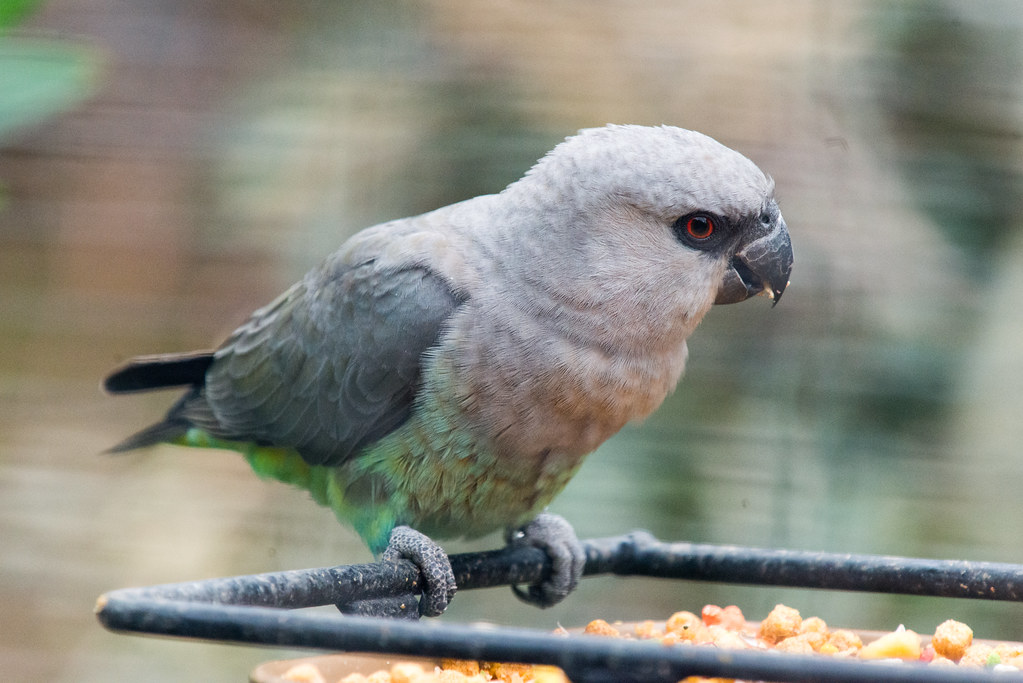Table of Contents
Red-Bellied Parrot: Your New Feathered Friend
Let’s take a closer look at the dazzling red-bellied parrot. Not only are they easy on the eyes, but these birds also have some interesting traits that set them apart.
Spotting a Red-Bellied Parrot
These guys are pretty small, standing about 23 cm tall and tipping the scales at around 140 grams. Their size makes them super agile, capable of some impressive aerial maneuvers.
Here’s what you need to look out for:
- Eyes: Those striking red irises are hard to miss.
- Beak and Feet: Both are a sleek dark gray.
- Male vs. Female: Males have a vivid orange chest and belly, while females show off a more muted greenish hue on their lower parts.
One interesting feature is how different the males and females look, a trait known as gender dimorphism.
Boy or Girl? Here’s How to Tell
Gender dimorphism in red-bellied parrots means males and females look quite different, even from a young age. Curious to see these differences? Check out the table below:
| Trait | Male | Female |
|---|---|---|
| Belly | Bright orange | Pale green with a touch of orange |
| Chest | Ashy-brown shoulders and neck | Gray on the upper part |
| Lower Belly | Deep orange | Pale green |
| Head | Pale blue underside | Pale gray |
Females also sport gray feathers on their chests and pale green feathers on their bellies. These differences add to the unique beauty of red-bellied parrots.
Knowing these traits helps us appreciate and care for these lively birds even more. For more avian adventures, don’t miss our article on the Senegal parrot and other parrot species.
Get ready to be amazed by your feathered friends!
Habitat and Behavior
Let’s dive into the fascinating world of the red-bellied parrot, focusing on where they live and how they behave. We’ll talk about their fondness for certain nesting spots, their tight-knit social groups, and their unique flight style.
Nesting Habits
Red-bellied parrots pick special places to call home. They’re not just going to settle anywhere—oh no, they’ve got standards! You’ll usually find them in hollow trees or even termite mounds. These cozy spots keep the little ones safe from nasty weather and hungry predators.
Imagine a neighborhood that’s hard to reach and hidden from view—that’s what these parrots look for. They’re quite the real estate aficionados, making sure their nests are well-concealed to protect their eggs and chicks.
Social Structure
These parrots are the poster birds for close-knit families. Typically, they live in pairs or tiny family groups of up to four birds (Oakland Zoo). It’s all about teamwork when it comes to feeding and raising their young.
What’s really heartwarming is their strong pair bonds. Picture them preening each other, not just to look good, but to stick together—literally! This behavior helps them stay tight as a group and boosts their chances of surviving out in the wild.
| Social Group Size | Description |
|---|---|
| Pairs | Lifelong mates, strong bonds |
| Family Groups | Up to 4 birds, cooperative care for the kiddos |
Flight Patterns
Watch out! When these parrots take to the air, they’re like little bullets darting just below the treetops. This speedy, low-flying style lets them zip through dense forests with ease.
Their flight isn’t just a sight to see—it’s a sound to hear. They screech loudly to chat with their friends and signal any dangers. Their unique flight moves help us understand how well they adapt to forest living.
By looking into where and how these parrots live, we get to appreciate what makes them so special. Want to know more about other types of parrots? Check out our detailed profiles on senegal parrots, african grey parrots, and eclectus parrots.
Reproduction and Life Cycle
Let’s take a fun, yet detailed, look at the life of red-bellied parrots, from their awkward teenage years to the hustle and bustle of parenthood. Brace yourself for the birdie lowdown.
Sexual Maturity
Red-bellied parrots, those feathery flirt machines, usually hit puberty around their first birthday. But hold up, they don’t usually get down to business until they’re around 3 or 4 years old (Oakland Zoo). Some of these eager birds might try their luck and be ready for action between 1 and 2 years, especially when spring fever hits. Knowing when they’re ready to breed is like having an inside scoop on their dating life.
Nesting and Hatching
When it’s baby-making season, red-bellied parrots get busy nesting. A typical nest will have 2 to 4 eggs, but you might see as few as 1 egg or as many as 3. Incubation lasts about 27 to 28 days (Beauty of Birds); another source says exactly 28 days for smaller clutches (Oakland Zoo). Here’s a quick rundown:
| Eggs in Nest | Incubation Time |
|---|---|
| 2 – 4 eggs | 27 – 28 days |
| 1 – 3 eggs | 28 days |
Chick Development
Once those tiny chicks peck their way into the world, they’re teeny-weeny, weighing in at a mere 0.2 oz. These little fluff balls depend on mom and dad for everything. In about 7 to 8 weeks, these chicks get their independence wings and leave the nest. But they’re still mommy’s and daddy’s babies for a bit longer, needing guidance until they’re about 12 to 14 weeks old (Beauty of Birds, Oakland Zoo).
| Stage | Age | Weight |
|---|---|---|
| Hatching | 0 days | 0.2 oz |
| Leaving the Nest | 7 – 8 weeks | – |
| Fully Independent | 12 – 14 weeks | – |
Understanding these stages helps us appreciate the busy life of these parrots and how best to pamper them through each stage.
Curious about other colorful chatterboxes? Check out more on parrot species, including the friendly senegal parrot and the superstar african grey parrot.
Parrot’s Predicament
IUCN Listing
Let’s talk about the Red-Bellied Parrot. According to the good folks at the International Union for Conservation of Nature (IUCN), they’re doing alright – they’re on the “Least Concern” list. That means their population is looking stable for now. But don’t go breaking out the party hats just yet.
| Species | Status | Population |
|---|---|---|
| Red-Bellied Parrot | Least Concern | Stable |
Threats and Bumps in the Road
Even though they’re “Least Concern,” don’t think for a second that life’s a walk in the park for these parrots. They’ve got their fair share of problems that could cause trouble down the line:
- Losing Their Home: With cities growing and trees getting cut down, these guys are losing their hangouts. They need those forests to nest and eat, and without them, they’re in a bit of a pickle.
- Weird Weather: The planet’s getting hotter, and weather’s getting wilder. This means their habitats could change or flat-out disappear. Nasty weather can wreck their nests and food supplies.
- Being Pet-napped: Snatching parrots from the wild to sell as pets is still a thing. And it’s not doing their population any favors.
Fighting Back for Survival
But hey, it’s not all doom and gloom. There are some heroes out there fighting to keep the Red-Bellied Parrot flying high:
- Saving Their Digs: Some awesome organizations, like the Audubon Society, are working their feathers off to protect and restore the natural spots these parrots call home (Audubon).
- Cracking Down on Pet Poachers: Enforcing tougher rules and penalties to stop illegal pet trading can help keep these birds in the wild where they belong.
- Spreading the Word: Teaching folks about why these parrots matter and how they’re at risk can get communities fired up to help out.
The struggle isn’t just for the Red-Bellied Parrot. The Orange-Bellied Parrot over in Southern Australia is in the same boat, facing habitat loss and predators. Programs focused on breeding in captivity, fixing up their habitats, and keeping them safe are crucial.
Want to nerd out more on parrots? Check out our takes on the African Grey Parrot and the Quaker Parrot for some cool facts and more info on their conservation status.
Caring for Your Red-Bellied Parrot: Tips You Can Use Today
Looking to make your red-bellied parrot feel right at home? From their diet to their day-to-day activities, it’s all about the little things. Let’s dive right in on how to keep these feathered friends happy and healthy.
What They Eat
Your red-bellied parrot needs a balanced diet. Here’s what to feed them:
- Pellets: This should be their main source of nutrition.
- Fruits: Think apples, berries, bananas—just keep it fresh.
- Veggies: Carrots, broccoli, leafy greens, you name it.
- Treats: Occasionally, toss in some multigrain bread, pasta, or sugar-free cereals for a little variety.
Stay away from too many fatty seeds like sunflower seeds to keep them healthy. For more detailed diet tips, check out our parrot species nutrition guide.
Home Sweet Home
Your red-bellied parrot needs a comfy living space that’s more than just a cage. Here’s what to consider:
- Cage Size: At least 24x30x24 inches so they have room to move.
- Toys Galore: Load up on toys they can climb, chew, and play with.
- Diet Variety: Mix in some seeds, beans, and rice along with their staple food.
A stimulating environment can make all the difference. For a few more tips, see our eclectus parrot housing guide; some ideas can overlap.
Making Friends and Training
Red-bellied parrots are social butterflies and love some good interaction. Effective training and socializing can turn them into even better buddies. Here’s how:
- Training Classes: Programs like the Bird Tricks Parrot Training Course can be super helpful (All Pet Birds).
- Daily Interaction: They love pets and cuddles, especially on their necks and heads, and they’re always up for some exploring.
Spending daily quality time with your feathered friend helps build a strong bond. Need more training advice? Our article on training a quaker parrot has some handy tips that work across breeds.
So, if you keep an eye on their diet, provide a cozy and playful home, and spend quality time with them, your red-bellied parrot will live a long, happy life. Happy bird caring!

